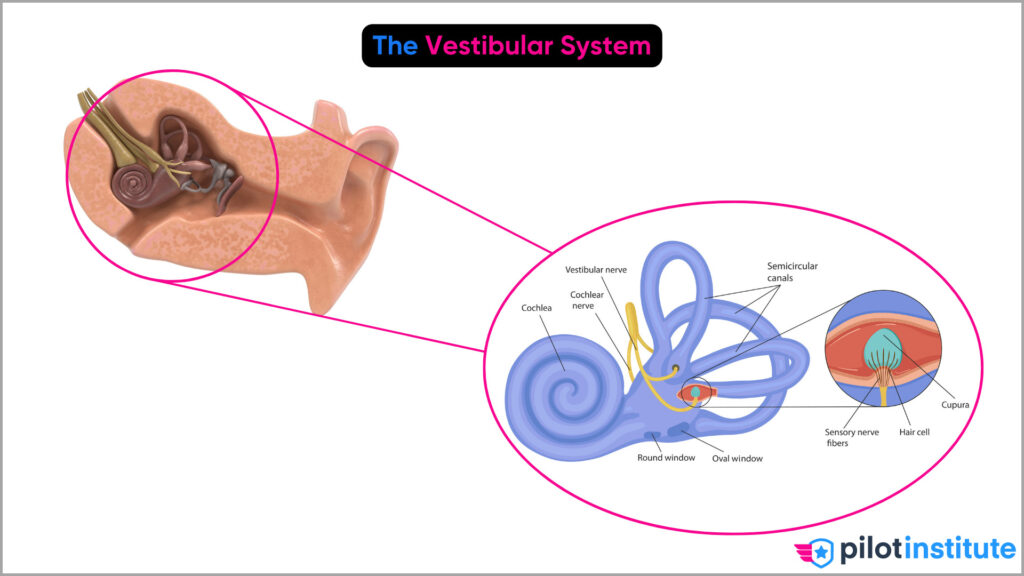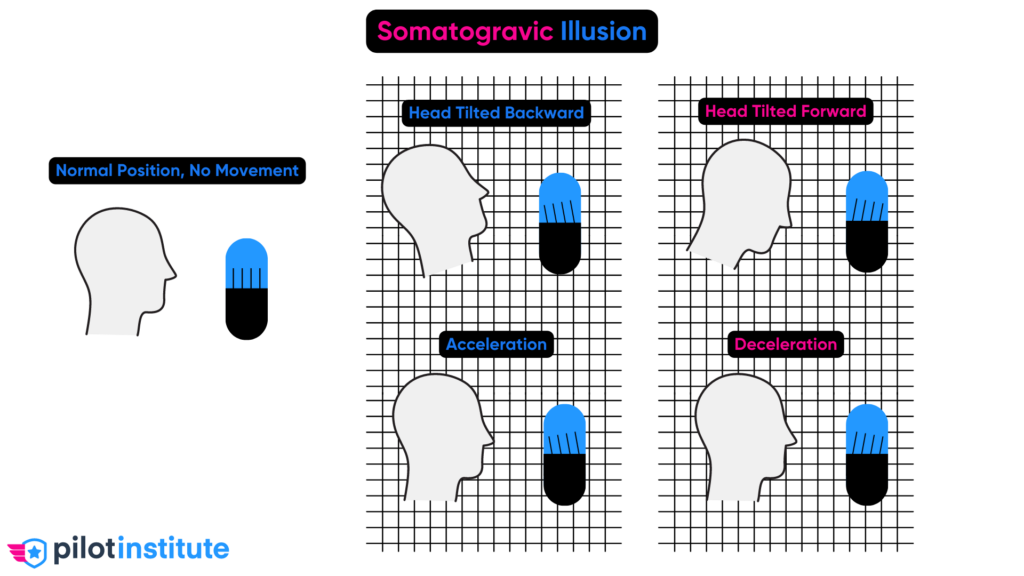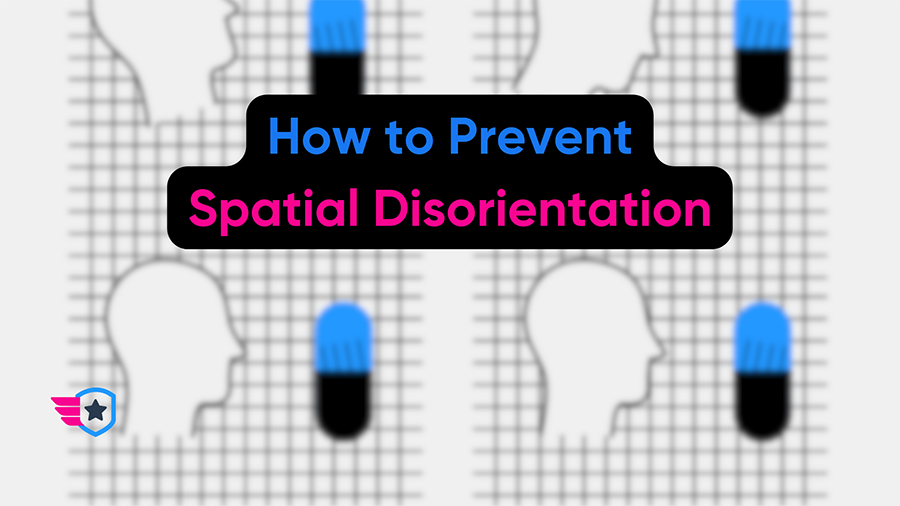-
What is Spatial Disorientation?
-
Understanding Somatogravic Illusions
-
Examples of Somatogravic Illusions
-
Somatogravic Illusions and Simulators
- Spatial Disorientation Training and Simulators
-
Somatogravic vs. Somatogyral Illusions
-
5 Ways to Prevent Spatial Disorientation
- 1. Understand the Science
- 2. Trust Your Instruments
- 3. Train Often
- 4. Keep Scanning the Instruments
- 5. Stay Healthy
-
Conclusion
You’ve buckled in, the engines are roaring, and you’re ready for takeoff. But flying through the clouds or a dark night could spell danger.
Spatial disorientation, an insidious threat to aviators, lurks in the unseen corners of your flight.
We’ve all heard of it, but do we know enough about one of its most dangerous types – the somatogravic illusion?
This illusion can turn your world, quite literally, upside down. It’s a deadly phenomenon that has led to numerous accidents.
But fear not.
With the right understanding, it can be conquered. Let’s shed some light on this often-underestimated hazard, and learn how to keep our skies safe.
What is Spatial Disorientation?
Spatial disorientation is like being blindfolded and spun around several times. When the blindfold is removed, you feel dizzy and unsure of which way you’re facing – left, right, up, or down.
Spatial disorientation is a condition where a pilot gets confused about where they are in relation to the ground. What they feel doesn’t match reality.
It can happen when what they see, what they feel, and what their body’s balance system tells them, don’t match up. This mix-up can make the pilot think the aircraft is moving in a different way than it really is, and that can be very dangerous.
A somatogravic illusion is a type of spatial disorientation due to acceleration or deceleration.
Let’s take a deeper look.
Understanding Somatogravic Illusions
The human body is a wonder of nature, but it wasn’t designed for flying. So, when we fly, some of our senses can get a little confused. The Somatogravic illusion is a prime example of this.
Our body senses movement and balance using the vestibular system in our inner ear. This system has tiny canals filled with fluid and tiny hairs. When we move, the fluid moves, which makes the hairs move, and this sends a signal to our brain telling us which way we’re going.

Here’s the catch. The fluid in our inner ear can’t tell the difference between the force we feel when we’re accelerating forward (like during takeoff) and the force we feel from gravity when we’re tilting our head backward. In both cases, the fluid moves in the same way.

So, when a pilot accelerates quickly, their brain might think their head is tilting backward. The brain concludes from this that the nose of the aircraft is pitching up, even if it’s not. This false sense is the somatogravic illusion.
In simple terms, our body’s balance system gets tricked by the forces of flying and tells our brain the wrong information about which way we’re going. As you can imagine, that can cause some serious problems in the air!
Examples of Somatogravic Illusions
Imagine this: You’re taking off in a low visibility situation – maybe it’s dark, or you’re flying in fog.
As your speed increases, you may feel like your nose is pointing too high, even when it’s not. That might prompt you to push forward on the controls, leading to a dangerous, low-altitude level flight or even a descent.
On the flip side, decelerating can make you feel like you’re nose-diving, even when you’re maintaining level flight. That illusion might cause you to pull up, climb, and potentially stall the aircraft.
It’s a slick piece of physiological deceit, courtesy of our otherwise trusty vestibular system. And it’s one that requires us to be vigilant and well-prepared to counteract.
Somatogravic Illusions and Simulators

Ironically, somatogravic illusions also save lives.
A simulator can’t physically recreate the continuous forward movement of an accelerating aircraft. It would require an impossibly long building! So, instead, it tilts the cockpit backward. This tilt creates a force on your body that’s very similar to the force you’d feel during a real-world acceleration.
Remember, our bodies can’t tell the difference between the force of acceleration and the force of tilting our head back. This is exactly what the simulator is exploiting.
As the simulator tilts the cockpit back, your inner ear senses this movement and interprets it as acceleration. Voila! You’re tricked into feeling as though you’re moving forward, adding a layer of realism to your flight simulation experience.
Spatial Disorientation Training and Simulators
You’re probably wondering, “Can’t we just train for these illusions in simulators?”
When it comes to somatogravic illusions, simulators have their limitations. Sure, they can mimic the visual aspect of rapid acceleration or deceleration, but they struggle to reproduce the false feelings generated in our inner ear. These feelings are crucial components of the somatogravic illusion, and without them, it’s tough to genuinely replicate the experience.
That’s not to say simulators are useless in this realm. They’re fantastic for teaching us to trust our instruments over our senses, a crucial skill in combating somatogravic illusions.
Somatogravic vs. Somatogyral Illusions
Spatial disorientation can take on many forms, and while we’ve been focusing on the somatogravic illusion, it’s important to mention its deceptive sibling, the Somatogyral illusion.
They’re related, but they play different tricks on your perception.
The Somatogravic illusion, as we’ve learned, is all about misleading you with false perceptions of pitch during acceleration or deceleration. Its partner in crime, the Somatogyral illusion, get you twisted with misconceptions about rotation.
For example, in a prolonged turn, your body adjusts to the constant rotation, and you might feel like you’ve stopped turning. If you then attempt to level the wings, your body can sense this change in rotation as a turn in the opposite direction. This could lead you to counteract an imagined turn, bringing you back into the original, unnoticed turn.
The common thread between these two illusions? They both mess with your senses and can create dangerous misunderstandings about your aircraft’s movements. Whether it’s an imaginary pitch change or an undetected turn, these illusions highlight the importance of relying on your instruments, not your senses.
5 Ways to Prevent Spatial Disorientation
So, how do we tackle this tricky foe called spatial disorientation? The key is a blend of preparation, practice, and a healthy respect for our human limitations.
1. Understand the Science
First, know your enemy. Understanding the science behind spatial disorientation is crucial. We’ve covered the basics here, but continue to read, ask questions, and learn more.
2. Trust Your Instruments
When in doubt, trust your instruments. They don’t succumb to illusions. If you feel a pitch or turn that’s not indicated on your instruments, it’s likely your body playing tricks on you.
3. Train Often
While flight simulators can’t perfectly mimic these illusions, they’re invaluable for teaching us to trust our instruments. Practice flying solely by instruments in a controlled, simulated environment. This experience will reinforce your ability to rely on your gauges rather than your potentially misleading senses.
Nothing beats training under simulated or actual Instrument Flight Rules (IFR), so try to get as much time in the actual aircraft as possible.
4. Keep Scanning the Instruments
Maintain a good instrument scan. Don’t fixate on one instrument, but continuously scan all of them. This helps you cross-check information and spot any discrepancies.
5. Stay Healthy
Fatigue, stress, certain medications, alcohol, and even minor illnesses such as the flu can greatly increase your vulnerability to spatial disorientation.
Conclusion
Spatial disorientation can be effectively managed with knowledge, training, and discipline. As pilots, we must learn to trust our instruments over our senses and maintain a healthy respect for the limitations of our human physiology.
In the end, it’s all about being prepared. Remember, flying is not only about handling the controls but also understanding and managing the forces that seek to disorient us.
Keep learning, keep practicing, and keep flying safely!



